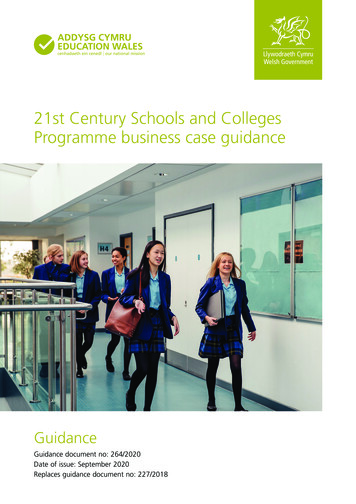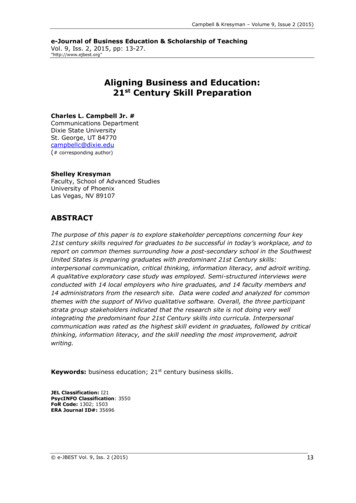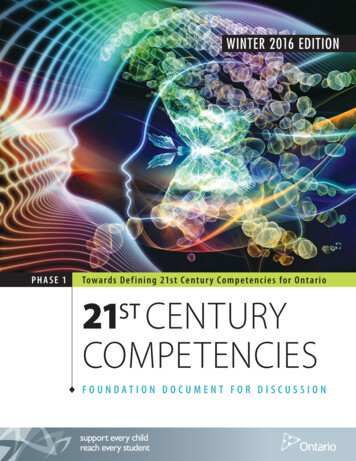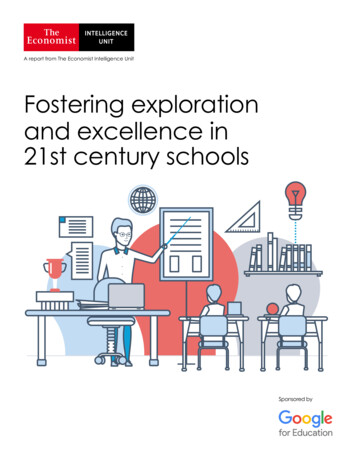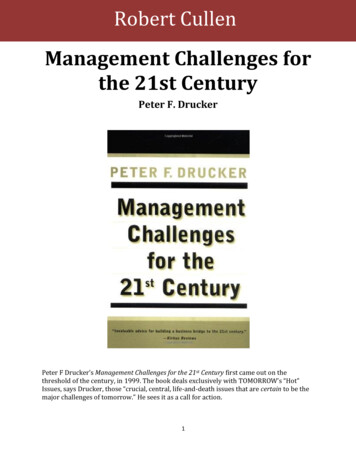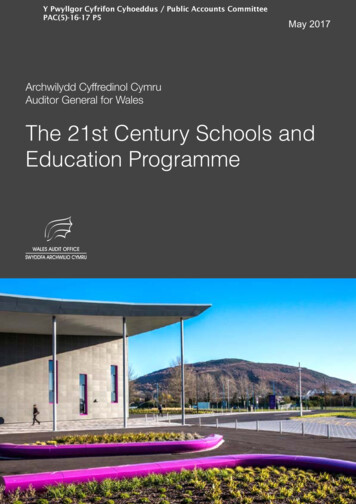
Transcription
Y Pwyllgor Cyfrifon Cyhoeddus / Public Accounts CommitteePAC(5)-16-17 P5May 2017Archwilydd Cyffredinol CymruAuditor General for WalesThe 21st Century Schools andEducation Programme
I have prepared and published this report in accordance with theGovernment of Wales Act 2006.The Wales Audit Office study team comprised Claire Flood-Page,Rachel Harries and Mark Jeffs under the direction of Matthew Mortlock.Huw Vaughan ThomasAuditor General for WalesWales Audit Office24 Cathedral RoadCardiffCF11 9LJThe Auditor General is independent of the National Assembly and government. He examinesand certifies the accounts of the Welsh Government and its sponsored and related public bodies,including NHS bodies. He also has the power to report to the National Assembly on the economy,efficiency and effectiveness with which those organisations have used, and may improve the use of,their resources in discharging their functions.The Auditor General also audits local government bodies in Wales, conducts local governmentvalue for money studies and inspects for compliance with the requirements of the Local Government(Wales) Measure 2009.The Auditor General undertakes his work using staff and other resources provided by the Wales AuditOffice, which is a statutory board established for that purpose and to monitor and advise the AuditorGeneral. Auditor General for Wales 2017You may re-use this publication (not including logos) free of charge in any format or medium. Ifyou re-use it, your re-use must be accurate and must not be in a misleading context. The materialmust be acknowledged as Auditor General for Wales copyright and you must give the title of thispublication. Where we have identified any third party copyright material you will need to obtainpermission from the copyright holders concerned before re-use.For further information, or if you require any of our publications in an alternative format and/or language, please contact us by telephone on 029 2032 0500, or email info@audit.wales. Wewelcome telephone calls in Welsh and English. You can also write to us in either Welsh or Englishand we will respond in the language you have used. Corresponding in Welsh will not lead to a delay.Mae’r ddogfen hon hefyd ar gael yn Gymraeg.
Contents14Summary6Recommendations14The programme is generally well-managed but the WelshGovernment will need to make some adjustments if the funding orapproach change for the next band of investment from 201920The Welsh Government set a clear, long-term direction which itspartners support although it will need to clarify its detailedexpectations and manage relationships if the funding orapproach change in future21The Welsh Government has a robust approval process which hasdeveloped over time but there is a lack of detail in the analysisunderpinning final decisions on projects32The Welsh Government manages its funding flexibly and thecurrent phase of the programme looks set to remain within budgetalthough there is uncertainty about future investment37The regional frameworks for procurement have been a positivedevelopment but could operate more effectively and will need tochange for Band B48Councils have generally valued the support provided by WelshGovernment in developing their programmes to date and newarrangements for specialist advice and technical support arebeing put in place52The 21st Century Schools and Education Programme
2The programme is beginning to deliver improved school buildingsand reduce surplus places but needs to get better valuefrom future investment55The programme is beginning to achieve improved schoolbuildings but many are still in poor or bad condition and there isscope to get better value from the investment56The programme has contributed to reducing the number of surplusschool places although difficulties matching demand and supplyremain65Identification and monitoring of wider benefits is patchy and thereare concerns that intended cost savings from energy efficiencyare not being achieved70Appendices78Appendix 1 – audit methods79Appendix 2 – profile of the 21st Century Schools and Educationprogramme81The 21st Century Schools and Education Programme5
Summary6The 21st Century Schools and Education Programme
1In 2009 the Welsh Government announced its 21st Century Schoolsprogramme (the programme). Its 2010 business case confirmed that itwas to be a long-term capital investment programme to improve learningenvironments and educational outcomes. It also aimed to enable councilsto address the long-standing problem of surplus school places and createa more sustainable education estate (Box 1). In 2012 the then Ministerfor Education and Skills invited further education colleges to submit theircapital investment priorities for inclusion within the programme1.Box 1: 21st Century Schools and Education Programme – aims and objectivesThe programme’s overarching aim is to act as an enabler to enhance teaching andlearning within a sustainable environment throughout the whole of Wales. To dothis, the Welsh Government, in partnership with the WLGA and councils will deliver: learning environments for children and young people in Wales aged from 3 to 19that enable the successful implementation of strategies for school improvementand better educational outcomes; a sustainable education system through better use of resources to improve theefficiency and cost-effectiveness of the education estate and which enhanceslocal public service provision; and a 21st Century Schools standard for all schools in Wales which reducesrecurrent costs, energy consumption and carbon emissions.2The programme is a collaboration between the Welsh Government,Welsh Local Government Association (WLGA), local authorities, Diocesaneducation authorities for the voluntary-aided sector and Colegau Cymru,representing further education. It is co-funded, with the Welsh Governmentproviding 50% of funds in most circumstances.1 Subsequently the programme is referred to as the ‘21st century schools and education programme’.The 21st Century Schools and Education Programme7
3The programme is intended to be long-term and is phased. Band A runsbetween 2014-15 and 2018-19. Initially, the Welsh Government intendedBand A to start in 2012 but, an unfavourable funding settlement in 2010led to the programme being paused. Councils reassessed their schoolsprogramme based on a 50% Welsh Government contribution rather thanthe initial suggestion of 70% government funding. At the end of 2011, theWelsh Government announced Band A of the programme from 2014. Italso made available 42 million of transitional funding for councils’ priorityprojects in the meantime. The total budget for Band A is around 1.5 billionwith a mix of new and substantially refurbished buildings. Councils muststill invest in smaller and routine maintenance to keep existing buildingsin good repair. The Welsh Government is currently working with councils,further education colleges and the voluntary-aided sector to develop plansfor Band B of the programme from 2019-20.4We reported previously on capital investment in schools in 20102 andthe National Assembly’s Public Accounts Committee then produced itsown report3. These reports identified weaknesses in the planning andmanagement of capital investment in schools and made recommendationsto be taken forward in the 21st Century Schools programme. In our currentreview, we have not sought to systematically follow-up progress againstthese recommendations. However, where appropriate we do commentin this report on whether the current programme is better than what wentbefore.5At what is still a relatively early stage in the programme, we haveexamined whether the Welsh Government’s arrangements for its designand delivery provide a sound basis for the programme now and in thefuture. We concentrate on Band A of the programme from 2014-15 andplans for Band B from 2019-20. We did not examine individual councils’decision making process in regard to school organisation or developingtheir local programmes. Nor did we examine the procurement of buildingand refurbishment works by individual councils or further educationcolleges or the operation of the procurement frameworks. We do notconsider councils’ expenditure on routine maintenance and minorrefurbishments or school buildings completed from 2014 but fundedoutside of the programme.6Overall, we have concluded that the Welsh Government is generallymanaging the 21st Century Schools and Education Programmewell but will need to clarify some detailed expectations and makeadjustments in response to proposed changes in approach andfunding to get better value from future public sector investment.238Auditor General for Wales (July 2010) Capital Investment in schoolsNational Assembly for Wales Public Accounts Committee (December 2010) Capital Investment inSchoolsThe 21st Century Schools and Education Programme
7It is clear from the evidence we have seen that the programme’s approachis a vast improvement on what went before. The shift from an annual grantto a long-term programme has led to a profound change in the approachto improving the education estate in Wales. In the past, the short-termfocus meant councils would patch-up school buildings to make them lastbeyond their expected life span. They were reluctant to start major, andoften controversial, school re-organisations without any guarantee of thefunding required to deliver those plans over many years. The programmeaddresses those underlying strategic problems and has been welcomedby councils across Wales. Indeed, the close working between the WelshGovernment and councils to develop and manage the programme is avery positive feature of this programme.8The Welsh Government is generally managing programme financeappropriately. Few projects, so far, have gone over-budget and the WelshGovernment is flexible in bringing forwards projects where there arepotential under spends. Overall, the governance arrangements aroundproject approval are robust. The Welsh Government has a sound processfor reviewing and approving the strategic plans for re-organising schoolsin each council area and the detailed plans for building or substantiallyrefurbishing individual schools. However, there does need to be sometightening up of the analysis to inform final Ministerial decisions.9The Welsh Government is now addressing some gaps where it did notset out its expectations clearly at the outset. In particular, it is now beingclearer about the detailed specifications of new schools (such as how bigclassrooms should be) and exactly what wider benefits the programmeintends to achieve. The Welsh Government’s requirement for councils tocome together to procure construction and refurbishment using commonregional frameworks is a positive development that could result inefficiencies of scale. In practice, these frameworks have not been used aseffectively as they could have been.The 21st Century Schools and Education Programme9
10The programme is starting to achieve new and refurbished schoolbuildings across Wales. The programme seems broadly on track toachieve the intended number of projects. Of the 176 planned schools andfurther education projects in the programme, 132 schools and six furthereducation projects have been approved. Of these, 59 are complete.There are 37 schools and one further education project in planning butwhich have not yet been approved. There have been some delays toprojects, particularly secondary school projects that have involved complexand controversial re-organisation of local schools. However, the WelshGovernment could have got better value, by requiring projects to adhereto industry standards from the outset and by encouraging the wider use ofbuilding information modelling in the construction process which has beenshown to be associated with substantially reduced costs. We estimate thathad industry standards for school sizes been applied throughout Band A,the programme could have saved between 28 million and 35 million.11It is difficult to be sure about the scale of change in the overall schoolestate and the remaining challenge. By the end of 2019-20 almost allschools that were classed as bad in 2010 should have been eitherreplaced or brought up to satisfactory or good condition. However,since 2010 many schools have deteriorated and are now in poor or badcondition. The scale of the remaining challenge is unclear. An independentreview of a sample of councils’ 2016 condition assessments changedthe councils’ original categorisations for almost four in ten schools.However, regardless of the quality of the data, it is clear that there remaina significant number of schools across Wales that are in bad or poorcondition or are unsuitable. The Welsh Government intends that by2024-25 there will be no ‘bad’ schools and the number of ‘poor’ schoolswill have reduced by 25%.10The 21st Century Schools and Education Programme
12The programme has contributed to a reduction in the overall number ofsurplus school places. In part, this is due to school re-organisations thathave closed down and merged schools. But demographic changes havealso contributed, with a rising birth rate at the start of this decade thathas seen a rise in the number of primary school pupils. Surplus placesin primary schools fell from 21% in 2010 to 13% in 2016. This figure iscloser to the Welsh Government’s target of 10% surplus places to allowfor changes within the year and some parental choice. Surplus places insecondary schools rose from 16% to 20.5% over the same period, but thispicture is likely to change as the current cohort of primary school childrenmove through to secondary school. These demographic factors varyconsiderably from council to council, with some still having large surplusplaces. Nonetheless, even in areas with high surplus capacity, individualschools may be oversubscribed. More recently, however, the birth rate hasdropped off significantly and it is this volatility that adds to the difficultiesfacing councils and the Welsh Government in predicting and planning forfuture demand, for primary education in particular.13The programme is contributing towards the Welsh Government’s goalof increasing the number of pupils learning through the medium ofWelsh. Planning for and meeting demand for Welsh-medium educationis complex. Building and refurbishing schools can only play a part inaddressing those issues. Our analysis suggests that councils haveprioritised Welsh-medium education in their school re-organisation plans,with more being spent per Welsh-medium learner than English. However,there remain a wider set of challenges if the Welsh Government is tomeet its ambitious targets to continue to increase the proportion of pupilslearning through the medium of Welsh from 21% in 2009 to 30% by 2020.14The evidence on the extent to which the Welsh Government is achievingthe wider benefits it intended is less clear: there is evidence to suggest that the project is leading to local economicand social benefits, but these have not been consistently measured andhave recently been defined more clearly; some new school buildings have not achieved the intendedenvironmental standards and there is widespread concern that energyefficiency technology has not delivered the expected cost savings; the evidence on attainment is unclear. It is difficult to establish a causallink between school buildings and educational attainment, but the WelshGovernment’s plans to get schools to track benefits post-occupancyshould help provide some clarity; the programme has led to new schools that are offering a wider range ofservices to the community.The 21st Century Schools and Education Programme11
15Looking forwards, the Welsh Government and its partners will need tomanage some new risks as well as learn from progress to date. The WelshGovernment is currently developing Band B of the programme, which willrun from 2019-20 to 2023-24. It has allocated indicative capital funding forpart of the period. Revenue funding of 500 million will also be availablefor design, build and facilities management of new facilities. This use ofthe Mutual Investment Model, the Welsh Government’s planned form ofpublic –private partnership to design, build, finance and manage newbuild schools raises new risks and challenges. The Welsh Government isworking with partners in terms of local funding contributions but at the timeof drafting this report, had not confirmed its funding plans. Many councilstold us that they are struggling to find the funding to continue to invest inschools. Councils have already significantly increased their borrowing andsold off assets in order to fund their contribution to the programme. At thetime of drafting, Councils and further education institutions are developingtheir plans for Band B. There is a degree of urgency to finalising thesefunding decisions as there is much work to do to plan and engagecommunities so that projects will be ready to start in April 2019.16Emerging plans for Band B suggest that the Welsh Government isintending to be more directive. The Welsh Government has already startedto be more robust in requiring projects to adhere to industry standards onsize and looking at standardising costs. It is also considering introducinga requirement for greater standardisation and joint procurement of newschool buildings across council areas. While there are strong argumentsthat this approach will provide better value for money buildings, the WelshGovernment will need to manage the risks that more centralisation andstandardisation poses to the collaborative ethos that the programme hasengendered to date.17Looking forwards, the programme will also need to operate in line withthe Well-being of Future Generations (Wales) Act 2015. The Act sets aframework of seven goals to develop and protect the social, economic,development and cultural well-being of Wales and five ways of workingto achieve sustainable development. Although the programme pre-datesthe Act, the way in which the programme was designed means thatit is already reflects, to some extent, the five ways of working (Box 2)and some of the Welsh Government’s well-being objectives4. There is,however, scope for improvement in some respects, or potential risks forthe future.412Welsh Government (November 2016) Taking Wales Forward: Welsh Government’s well-beingobjectivesThe 21st Century Schools and Education Programme
Box 2: The Well-being of Future Generations (Wales) Act 2015Way of workingWales Audit Office commentaryLong TermThis is a long-term programme running for at least ten years. ForBand B and beyond the Welsh Government faces the challenge ofclarifying the funding arrangements for the longer-term, includingbalancing short-term benefits and long term costs of using privatefinance to part-fund the programme.PreventionThe programme aims to support wider policy goals of early years’intervention including using schools to provide community facilitiesfor families. Its emphasis on creating an estate that can deliver themodern curriculum and support attainment is intended to preparepupils for life. The Welsh Government recognises that, together withcouncils, it needs to do more to ensure schools are seen and usedmore as a community resource.IntegrationThe programme has clear elements of integration, from a strategyto integrate school building with wider education, through to detailedgovernance arrangements that involve different parts of WelshGovernment and other sectors, including councils, further educationand faith schools.CollaborationThe programme has been designed and managed in a genuinecollaboration between the Welsh Government and councils. Goingforwards, there are risks balancing the collaborative ethos withemerging plans for greater central control over the programme andthe design of schools.InvolvementThe Welsh Government has established processes for involving andconsulting with all partners, learners, parents and the general publicabout school organisation in the 2013 School Organisation Code.There are examples where designers and builders have includedlearners and teachers in decision-making about the planning anddesign of new and refurbished buildings. Going forwards, sustainingpublic and staff engagement may be more challenging if there is amove to more standardised buildings although this is not inevitable.The 21st Century Schools and Education Programme13
RecommendationsThe Welsh Government has shown a commitment to improving and refining itsarrangements for the programme. We are aware that the Welsh Governmentis developing its approach and thinking in many of the areas covered by therecommendations for improvement below.Ensuring that the programme’s governance arrangements remain fit forpurpose as the approach and funding develop for Band BR1Overall, our view is that the governance arrangements for overseeingand approving projects are sound. However, we found that the finaladvice put to Ministers, on which to base their funding decisions, didnot adequately reflect outstanding risks and concerns with the projects.The Welsh Government has subsequently updated its approach butthere is scope to go further. The Welsh Government should ensurethat Ministerial briefings on which funding decisions are taken setout the actions taken in response to any concerns or conditionsidentified by the Capital Investment Panel.R2Going forwards, the Welsh Government is likely to make somesubstantial changes to the way the programme is funded andmanaged. The Welsh Government will need to finalise updatedgovernance arrangements for Band B of the programme that takeappropriate account of:a the complexities of making use of revenue funding, learningfrom the experience of other parts of the UK; andb any shift in the balance of funding between partners.14The 21st Century Schools and Education Programme
Clarifying the approach to funding for councils, church schools andfurther education colleges for Band BR3The Welsh Government is currently consulting with councils and furthereducation colleges about the funding for Band B and, in particular,if there is appetite to participate in the Mutual Investment Model.Recognising this on-going work, the Welsh Government should setout its plans for funding Band B of the programme as soon aspossible, taking into account:a the volume and cost of the remedial work required to bring allschools in Wales, including voluntary-aided schools, up to agood or satisfactory standard; andb the capacity of councils, further education colleges and thedioceses to fund further capital or revenue based investment inschools.Developing an up to date, reliable picture of the condition andsuitability of the education estateR4A national condition survey in 2010 helped to provide a clear baselineon the condition and suitability of the school estate, although there hasbeen little public reporting of the data or the progress of the programmenationally. Since then, councils have updated their data annually. Asample survey was also carried out in 2016 to assess consistency ofdata. Given the proportion of schools that were judged to be incorrectlycategorised, we recommend that the Welsh Government:a urgently issue updated guidance on classifying schools,setting out any common issues and errors identified in thesample review;b require councils to update their assessment of every school,based on the updated guidance;c carry out another review of a sample of the data to checkthat councils are applying the categories correctly andconsistently; andd report publicly on progress to improve the condition andsuitability of the school estate alongside achievement of widerbenefits.The 21st Century Schools and Education Programme15
Addressing surplus places and school place planningR5The programme has prioritised the reduction of surplus places andhas been one of several factors contributing to a fall in surplus placesalthough most councils are still above target, especially for secondaryschool places. For Band B, the Welsh Government is prioritisingbuilding condition more than surplus places. The Welsh Governmentshould continue to work with councils to:a ensure that the programme continues to contribute to areduction in surplus places despite the shift in priorities,especially in those council areas where a growth in thesecondary age population is not expected;b ensure that building programmes for Band B appropriatelyreflect local demand for Welsh-medium education and theWelsh Government’s intentions to substantially increase thenumber of pupils learning through the medium of Welsh;c engage with Diocesan authorities to assess the likely demandfor faith schools across Wales; andd identify cost effective and timely approaches for councils thatface acute pressures for new places.Creating a sustainable estate with lower running costsR6Some of the completed new school buildings are not achieving theWelsh Government’s energy efficiency and sustainability targetsfor the programme. We recommend that the Welsh Governmentstrengthens its work with councils to:a liaise with industry experts to understand the gap betweenexpected and achieved energy efficiency performance and howit can be remedied and reduced in future projects;b challenge business cases that rely on significant savings fromenergy efficiency technology in the whole life cost assessmentrobustly; andc encourage schools to assess their energy use when thebuilding is first occupied and then annually to ensure that theyare benefitting from the anticipated recurring savings in energycosts.16The 21st Century Schools and Education Programme
Ensuring more cost effective procurement of projectsR7Analysis of the costs of completed Band A projects shows significantvariation in the total costs as well as in ICT and fixtures, fitting andequipment costs. New schools have exceeded the maximum industryarea standards by 7-10%. Some projects are using an approachknown as Building Information Modelling in the design and constructionphases that has been shown to achieve time and cost savings as wellas improving quality. The Welsh Government should build on workalready carried out to:a reach agreement with councils, other partners and industryrepresentatives on the options for bringing greaterstandardisation to the projects including floor area andelements of the build;b require the use of Building Information Modelling in projectswithin the programme; andc provide more detailed guidance about the level of IT andfixtures, fittings and equipment that can be funded from theprogramme to ensure consistency between projects.The 21st Century Schools and Education Programme17
R8There is evidence that the regional procurement frameworks are notoperating as intended, with some duplication and councils not adoptinggood practice in procurement methods. The Welsh Governmentshould:a ensure that councils adopt accepted good practice in theapproach to construction, with a presumption in favour ofdesign and build (excepting projects funded through theMutual Investment Model);b improve communication with industry on the likely timing andscale of work under the frameworks;c understand and address the reasons why some councilsare conducting pre-tender exercises despite contractorsalready having gone through the same process to get on theframeworks; andd engage stakeholders, including councils and the constructionindustry, in developing and finalising the procurementframeworks in light of changes for Band B.Achieving wider benefits from programme investment and sharinggood practiceR9The Welsh Government has now established more clearly than inthe past what benefits it wants to achieve through the programme.It has established a discrete set of targets for local supply chain,apprenticeships and training and STEM engagement with schools. Itis also clear that a future priority will be to make more community useof the school buildings. To increase the wider benefits flowing frominvestment in the programme, the Welsh Government should:a ensure that its targets for projects remain stretching over time;b promote good practice in achieving community benefits, forexample through regularly updating the 21st century schoolswebsite, regional networks and industry events; andc review how the identified barriers to increasing communityuse of school buildings can be addressed in Band B of theprogramme.18The 21st Century Schools and Education Programme
Ensuring that a suitable level of technical skills and knowledge isavailable to the programme team and councilsR10The Welsh Government has put in place arrangements for technicalsupport to the programme. It has strengthened the capacity of itsown team through recruitment of experts in public-private finance. Itis also setting up framework contracts to provide technical support tocouncils. Given the technical changes to the programme underBand B, the Welsh Government should, at the end of 2018, fullyreview whether the arrangements are working to:a provide the Welsh Government with the technical expertise itneeds to manage and oversee the programme; andb provide councils with the technical support they need to planand deliver the programme locally.The 21st Century Schools and Education Programme19
Part 1The programme is generallywell-managed but the WelshGovernment will need to make someadjustments if the funding or approachchange for the next band of investmentfrom 201920The 21st Century Schools and Education Programme
1.1 In this part of the report, we examine the Welsh Government’sestablishment and management of the 21st Century Schools andEducation programme (the programme). We report both on thearrangements for Band A from 2014-2019 and developing plans for BandB from April 2019. The majority of our analysis focuses on schools whichnecessarily form the bulk of the programme. However, we also includereferences to further education colleges in Wales
The 21st Century Schools and ducation rogramme 7. 1 In 2009 the Welsh Government announced its 21st Century Schools programme (the programme). Its 2010 business case confirmed that it was to be a long-term capital investment programme to improve learning environments and educational outcomes. It also aimed to enable councils


